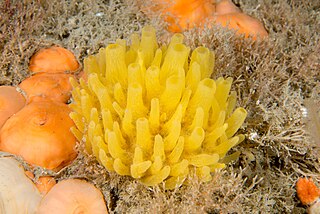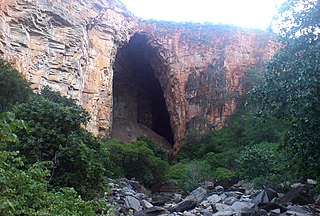
Polymastia is a genus of sea sponges containing about 30 species. These are small to large encrusting or dome-shaped sponges with a smooth surface having many teat-shaped projections (papillae). In areas of strong wave action, this genus does not grow the teat structures, but instead grows in a corrugated form.

Plakinidae is a family of marine sponges. It is composed of seven genera:

Cryptachaea is a genus of spiders in the Theridiidae family.

Spicules are structural elements found in most sponges. The meshing of many spicules serves as the sponge's skeleton and thus it provides structural support and potentially defense against predators.
Racekiela ryderi is a species of freshwater sponge in the family Spongillidae. It was first described by Edward Potts in 1882. It was collected on Sable Island in 1899 by John Macoun, a biologist with the Geological Survey of Canada, and given the name Heteromeyenia macouni by A.H. Mackay in 1900. It was originally assumed to be endemic to Sable Island but is now considered to be the same species as Racekiela ryderi, which is more broadly distributed.

Amphimedon is a genus of sponges with over 60 described species. In 2009, Amphimedon queenslandica was the first species of sponge to have its genome sequenced.

Spongilidae is a family of sponges that live in freshwater lakes and rivers. The following genera are recognized in the family:

Chondrilla is a genus of sea sponges belonging to the family Chondrillidae.

Lapa dos Brejões is a complex of caverns formed in Neoproterozoic limestones of the Una Group of caves along the Jacaré river, northeast side of the Irecê sedimentary basin. It is located in the northern portion of the Chapada Diamantina - Polígono das Secas, in the north central part of the State of Bahia, about 500 km (310 mi) from the capital Salvador, Brazil. According to local people, the Lapa dos Brejões was discovered in 1877, but the first discoveries inside the cave were published only in 1938 by Father Camilo Torrendt.

Potamolepidae is a family of freshwater sponges, with seven genera:
Metaniidae is a family of freshwater sponges, with five genera and 26 species:

Aplysina is a genus of sea sponges in the order Verongiida. It was first authenticated and described by Giovanni Domenico Nardo in 1834.

Anheteromeyenia is a genus of freshwater sponge. It has been recorded in the Nearctic, the Neotropics. This taxon was initially a subgenus of Heteromeyenia when K. Schöder circumscribed it in 1927, but W. M. de Laubenfels made it a genus in its own right in 1936.

The Constituent Cortes of 1820, formal title The General and Extraordinary Cortes of the Portuguese Nation, also frequently known as the Sovereign Congress or the Cortes Constituintes Vintistas, was the first modern Portuguese parliament. Created after the Liberal Revolution of 1820 to prepare a constitution for Portugal and its overseas territories, it used a different system from the traditional General Cortes for choosing representatives, and the three traditional feudal estates no longer sat separately. The Cortes sat between January 24, 1821 and November 4, 1822 at the Palácio das Necessidades in Lisbon. The work of the Constitutional Cortes culminated in the approval of the Portuguese Constitution of 1822.











